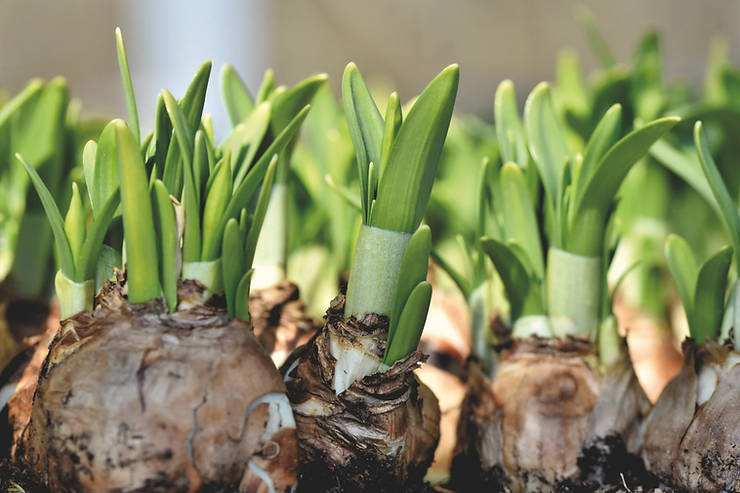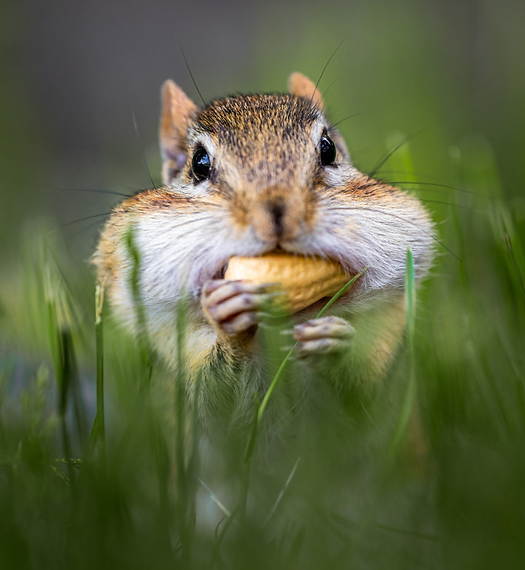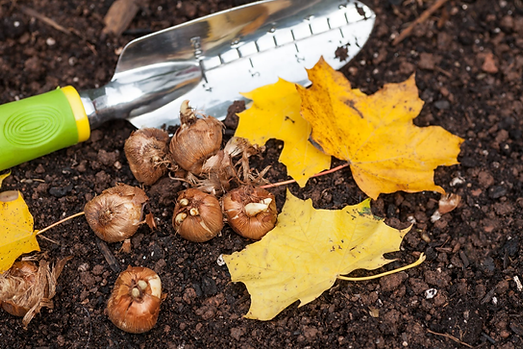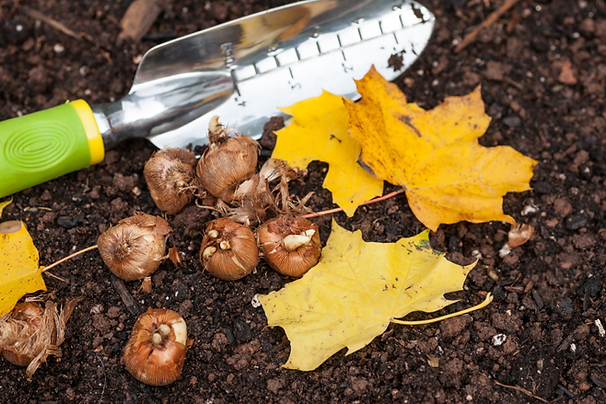There’s nothing more exciting, at least for a gardener, than to see the first push of life pop up from a cold, desolate landscape. It brings the promise of spring with warmer temperatures and longer hours of sunshine. You too can experience this little jolt of excitement by preparing your yard now. It is that time of year again to sprinkle your yard with lovely spring blooming bulbs. But when actually is that time of year? Read on to learn how late you can plant spring bulbs in the fall and some tips on how and where to plant them.
(Some of the links within this post are affiliate links on which I receive a small compensation from the sale of certain items with no extra cost to you.)
(As an Amazon Associate I earn from qualifying purchases.)
What Bulbs Need to Bloom in the Spring
Bulbs need to go through a chilling period in which they are half asleep. Colder days and nights, along with shorter sunlight hours, trigger the bulbs into a state of dormancy. This period allows them to grow their roots deeper and deeper into the soil. The colder soil helps bring on a chemical change that aids in producing beautiful blossoms in the spring.
This chilling process helps the bulb produce energy needed to push out blooms in the spring. The bulb is like a holding vessel that contains everything the plant will need in order to grow big and beautiful. It is quite an energy storage system!
The bulb is amazing. It knows when to wake up because its little “stopwatch” keeps track of the time it was chilled, and then begins to awaken when the soil is warmer, temperatures are warmer, and days become longer. Hormonal changes begin and that’s when they begin to grow.

Is it Ever Too Late to Plant Spring Bulbs in the Fall?
For Colder Climates
Some say you should begin planting flowering bulbs for next spring when the crickets stop chirping, the squirrels start scavenging for acorns and nuts, and/or the first frost appears in the morning.
But I say it is never too late to plant bulbs in the fall through early to mid-winter if you live in cold zones, zones 7 or lower. As long as the ground is not frozen, you will be able to penetrate the soil and plant your bulbs. Sometimes the top half inch or so of soil may be frozen, but as long as you can easily dig beyond that, you’re good to go.
For Warmer Climates
If you live in zones 8 through 11, the ground will not get cold enough for the bulb to properly develop. If you live where the ground does not freeze, you need to simulate the chilling period. Leave the bulbs in the bag you bought them in, and place them in the refrigerator approximately 6 to 10 weeks. Plant them in late February or early March. Do not store them with fruit because the gases the fruit emits will destroy the bulbs.
Is It Ever Too Soon?
If you begin planting the bulbs through September when the ground is still warm and there are more sunlit hours, you may experience some of the problems listed below.
1. The endearing squirrels and other critters will dig them up and have a wonderful feast.
2. The bulbs will get confused by the warmth and begin pushing up above the ground when you do not want them too! OR, once the frost and freezing temperatures come, the tiny, delicate sprout will shrivel and die. When bulbs start blooming prematurely, they will not produce a beautiful blossom because their root system has not fully developed.
3. Bulbs may rot from water saturated ground.

Consequences of Planting Bulbs in December or January
Like I said, you can still plant bulbs in December through January if the ground is still workable. However, planting late may have some adverse effects.
1. The flowers will not be as large.
2. If you plant tulip or daffodil bulbs at the end of January, the flower will bloom later than usual.
3. You can improve the chances of an early bloom by delaying the planting process. Put them in a paper bag and place them in the refrigerator until they sprout (could take up to 3 months). Then plant them in late spring.
Tips for Planting Bulbs Late in the Fall Season
1. Take advantage of sales. Most box stores want to unload their inventory to make way for Christmas decor. Now is the time to get some really good deals.
2. Select firm bulbs without any mold.
3. Clear any snow away and start digging. If the ground is not completely frozen, it will be easy to dig down to the appropriate depth.
4. Take a picture of the area where you planted the bulbs as a reminder after a long hard winter.
Shop For Bulbs At Etsy
How to Plant Bulbs in the Autumn
There are a few things to keep in mind when planting bulbs in the Autumn.
<h3Plant Fall Bulbs
Make sure you are planting fall bulbs. There are other varieties of flowering bulbs that are exclusively planted in the spring to bloom throughout the summer. Read the package carefully to be sure you are purchasing the proper bulbs. The only bulbs sold this time of year should be ones to be planted now.
Select bulbs according to their light requirements. Most early spring blooming bulbs will require either filtered or full sunlight. In early spring the leaves on deciduous plants have not yet opened up, so you will continue to have filtered sunlight even under a canopy of trees such as maples and oaks. However, do not plant them in areas that are shadowed by structures such as homes, buildings, or sheds. They will not receive enough needed sunlight. Also, if the flower you selected blossoms in late spring, remember the leaves on trees will have matured by then, creating more shade.
Plant Them to the Proper Depth
Different sizes of bulbs require different depths. Generally speaking, the larger the bulb, the deeper it should be planted. The smaller the bulb, the more shallow. Read the directions on the package for more in-depth instructions.
If you are only planting a few bulbs, dig the holes individually. If you have a mass of bulbs, dig out an entire area to the proper depth and place the bulbs pointed side up. Then gently cover them with soil. The shoots grow from the point and the roots grow from the flat side of the bulb.
If you cannot tell the top from the bottom, place them on their sides. The shoots will naturally grow up and the roots grow down.
Use a multi-purpose garden knife with the depth marked from Amazon for easy planting. You want to make sure you have a sturdy tool to prevent bending when digging into hard soil.
For more information on bulbs, click What Flower Bulbs to Plant in the Fall.

Forcing Bulbs to Bloom Before the Spring
Plant the bulbs in a pot, stash them in a cold, dark location for a few weeks, then place them inside in a sunny, warm location to force them to bloom. Below is a list of approximate times to chill the bulb. For more information on forcing bulbs, click White Flower Farm.
Recommended Rooting Times for Cold-Hardy Bulbs
- Anemone (Windflower): 8-10 weeks
- Chionodoxa (Glories of the Snow): 10-12 weeks
- Crocus (Spring-blooming Crocus): 8-10 weeks
- Galanthus (Snowdrops): 10-12 weeks
- Hyacinthus (Hyacinth): 12-14 weeks
- Dwarf Iris (Iris reticulata and other spring-blooming bulbous species): 10-12 weeks
- Leucojum (Summer Snowflake): 8-10 weeks
- Muscari (Grape Hyacinth): Store cool and dry for 6-8 weeks, then give 2 weeks of cool rooting time
- Trumpet Daffodils: 14-16 weeks
- Large-Cupped Daffodils: 15-17 weeks
- Small-Cupped Daffodils: 16-18 weeks
- Double-Flowered Daffodils: 16-18 weeks
- Split-Corona Daffodils: 14-16 weeks
- Narcissus (Triandrus): 16-17 weeks
- Scilla (Squill): 10-12 weeks
- Tulipa (Tulip): 14-16 weeks
How Late Can You Plant Fall Bulbs?
You can plant your bulbs well into the winter as long as the ground is soft enough. Remember, it’s better to plant them in the ground than leave them somewhere in a bag.
Storing Bulbs
If you really cannot get to planting them in the fall, store tender bulbs in a paper bag, reusable mesh bag, or a cardboard box with air holes for air circulation. Keep the bulbs separated by cushioning them with peat moss, sawdust, or vermiculite. They need enough air circulation to prevent rotting. For more information, check out MasterClass.
The effort you put forth now will result in beautiful spring blossoms next year when you’re anxiously waiting for spring to be sprung.
I hope you enjoyed this post and learned a thing or two about when to plant spring bulbs in the fall. Please leave a comment below and share this with friends and families.
Happy Gardening!
Nina
bestgardeningforbeginners@gmail.com
www.bestgardeningforbeginners.com

